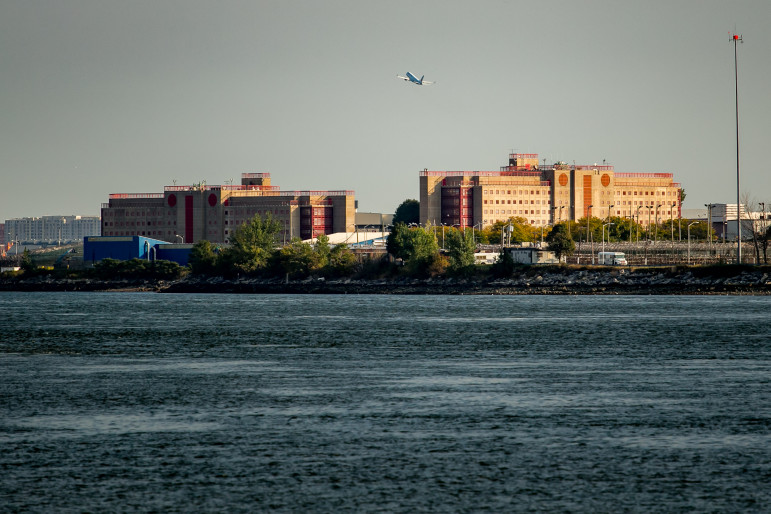“It’s an issue that seems to be within DOC’s control, something they can anticipate, and yet they’re really not able to make sure that the conditions are humane for the people that are forced to be there,” one civil rights attorney said.

Adi Talwar
George R. Vierno Center on Rikers Island, seen from the Bronx.
At a press briefing on Thursday, a day before the heat index was predicted to reach 108 degrees, Mayor Eric Adams implored residents to be on guard, and to take refuge at one of the city’s cooling centers, public pools or beaches.
“Access to cooling is a matter of life and death,” the mayor told the crowd. “It is essential that all New Yorkers stay cool.”
But that isn’t an option for all New Yorkers, including those in the city’s jail system, where just more than half, or 56 percent of the population, is being housed in air-conditioned units this summer, according to the Department of Correction.
While the DOC issues a “heat action plan” for its jails each year that outlines actions it takes to keep those in custody cool—including providing access to AC, ice, and cold showers—lawyers who spoke with City Limits say the agency uses the same boilerplate language every year, and continually fails to live up to its promises.
“They might have said there was a heat plan on paper, but there was no heat plan,” said Douglas Powell, a community leader at VOCAL-NY, who was detained at Rikers Island from 1988 to 1989 and then again from 2009 to 2012.
“It’s just like a lot of things in DOC; they have more than adequate policies, but the ability of line staff to carry it out or management to ensure that it’s carried out is lacking in every area of prison life,” added Robert Quackenbush, a staff attorney with the Legal Aid Society’s Prisoners’ Rights Project.
Sources who spoke with City Limits shared cases of broken or insufficient AC, fans blowing around hot air, and people waking up in their cells in pools of sweat due to poor ventilation. With July on track to be the Earth’s hottest month on record—and a predictor of brutal summers to come—the need for relief has only become more pressing.
“It’s an issue that seems to be within DOC’s control, something they can anticipate,” said Lucas Marquez, director of civil rights and law reform at Brooklyn Defender Services. “And yet they’re really not able to make sure that the conditions are humane for the people that are forced to be there.”
For example, a man being held at the Vernon C. Bain Correctional Center (VCBC)—a city jail barge in the South Bronx also known as “the boat”—told his attorney that the dorm he was cooped up in had gone without air conditioning for the first several weeks of summer, according to Brooklyn Defender Services, which is representing him.
The group housed in the dorm—whose members are considered “heat sensitive” under DOC guidelines—spent their nights tossing and turning, the uncomfortable conditions keeping them awake. The man told his attorney that the metal surface of the boat soaked up the heat so quickly that it created “sweltering” conditions for those inside.
People considered “heat sensitive” have underlying health conditions that make them more vulnerable to high heat. As a result, they are supposed to be placed in climate-controlled dorms that can maintain a temperature below 80 degrees, per DOC policy.
It wasn’t until July 4, the day temperatures reached a record high, that engineering staff came in to fix the problem, according to Brooklyn Defender Services’ client. A DOC spokesperson claimed the unit “had access to AC prior to July 4” but did not specify for how long. The spokesperson confirmed that the AC was repaired on the holiday, but said temperatures in the unit were recorded that day just below the 80-degree mark and that “the issue was abated within 8 hours.”
According to DOC’s own data, as of May, 85 percent of the people held in city jails who are deemed “heat sensitive” were housed in air-conditioned housing units.
“It’s not possible to add air-conditioning in every facility and housing unit,” the DOC’s heat plan reads, citing “the age of the infrastructure” in some of its buildings. “The Department looks forward to new borough-based jails, which will be designed with climate control features throughout,” the plan continues, referencing the new jails slated to replace Rikers Island, part of a plan to close the troubled jail complex by 2027.*
This latest bout of hot weather comes as Rikers remains ensnared in a larger, years-long humanitarian crisis. In recent weeks, many have called for the federal government to take over operations of the troubled jail complex, citing ongoing violence, dysfunction and a lack of transparency on the part of DOC leadership.
Earlier this month, a federal monitor issued a report which paints a gruesome picture of the unsanitary and unsafe conditions inside New York City jails, including Rikers, where around 6,000 people are being held, most of whom are awaiting trial and have not yet been convicted of a crime. The report—which covered the period of January 2023 to April 2023—cited thousands of violations revolving around fire safety, ventilation, sanitation, and staffing issues.
The federal monitor was created as a result of a class action lawsuit filed by the Legal Aid Society in 1975 challenging environmental conditions in the city’s jails. DOC used to be required to identify heat sensitive individuals across all Rikers facilities and transfer them to air conditioned spaces under a court order from that case.
But in 2015, after years of back and forth between DOC and Legal Aid Society, the city moved to terminate the order, according to Quakenbush. DOC is now bound only by their own policy to identify heat sensitive individuals and relocate them to climate-controlled spaces, but the consequences of failing to do so are far less grave, he said.
“The case used to be about many, many, many, many topic areas, including all types of jail life, but over the years it has been whittled down to just a core few areas and extreme temperatures for the most part is not included within it,” said Quackenbush.

Michael Appleton/Mayoral Photography Office
“Access to cooling is a matter of life and death,” the mayor said at a public briefing Thursday about the expected heat wave.The NYC Board of Correction, the agency that monitors the city’s jails, also performs oversight of heat conditions at DOC facilities, though the regulatory agency’s most recent heat report was published in the summer of 2021. A spokesperson for the Board told City Limits it “has commenced monitoring the Department’s heat mitigation protocols” this summer, and will publish its findings in the coming months.
This week, a client told Brooklyn Defender Services that the air conditioning in his unit at Rikers Island’s Robert N. Davoren Complex (RNDC) is not working, and that there is just one fan to go around for the 42 men housed there. When the men asked about getting another fan, staff told them there was only one outlet.
Without cooling systems in place, those in the unit are sweating through their clothes at night, the client told his attorney.
The DOC’s heat plan also calls for people in custody to have access to showers throughout the day. According to the agency, cool showers are provided in non-air-conditioned areas. Brooklyn Defenders’ client said that at his unit at RNDC, the water only comes out hot, leaving limited options to cool down when the AC is not working.
A DOC spokesperson told City Limits the agency monitors water temperatures at its facilities. The agency did not respond to queries about how many AC outages its jails have experienced so far this season.
On July 14, members of the City Council’s Black, Latino and Asian Caucus (BLAC), including Councilmember Shahana Hanif who oversees District 39, toured parts of RNDC, which houses adolescent and adult men.
During the visit, which was coordinated with the DOC, Hanif said it was extremely hot and that it wasn’t clear if people held there were receiving ice and water.
In the protective custody unit Hanif visited, she noticed only one big fan at the end of the hallway, contradicting DOC’s heat plan, which says spaces without AC must have at least two fans provided.
“I felt like I was in a sauna,” said Hanif. “Just dripping in sweat.”
It was unclear to the councilmember how cool air could reach cells where people are held, especially when the doors are closed at night. Cell doors can be a major problem, Quackenbush added, not only because they provide poor ventilation, but because they block sound and limit staff’s line of sight, making it more difficult for them to check on the condition of those inside.
In 2014, Jerome Murdough, who was being detained in a mental health unit at Rikers, died after the temperature in his cell surpassed 100 degrees. Officials at the time said that Murdough hadn’t been checked on for at least four hours.
According to Correctional Health Services, which provides medical care to people in New York City’s jail system, none of their patients have been sent to the hospital this year or last year for heat-related illnesses.
Louis A. Molina, the chief commissioner for New York City jails, has drawn increased scrutiny for withholding information about investigations on deaths and serious injuries at Rikers. In May of this year, the commissioner ended the practice of informing news outlets of deaths at the jail complex, where seven people have died this year.
That same month, the City Council passed a bill aimed at reducing the jail’s population. Councilmembers are still pushing for the city to close Rikers by the 2027 deadline, as outlined in the $8 billion plan the Council passed in 2019.
“We want Rikers closed and at the same time, we want people to not die of a heat attack,” said Hanif.
*This story was updated since original publication to include additional detail from the DOC’s heat plan.








